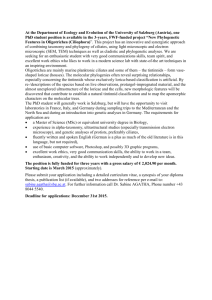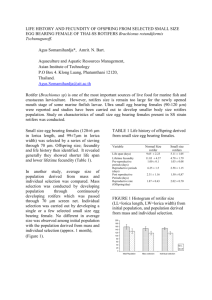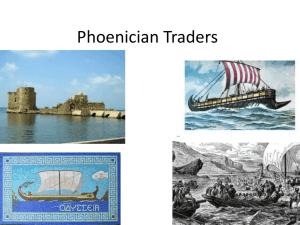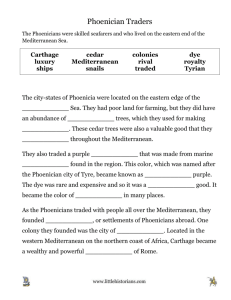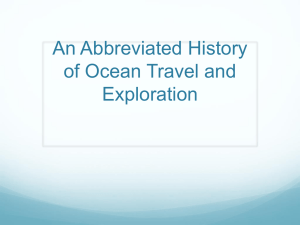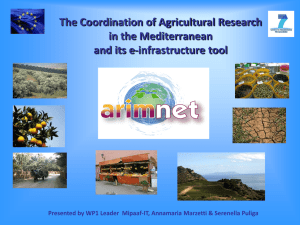A preliminary study of tintinnid diversity in the NW Mediterranean Sea
advertisement
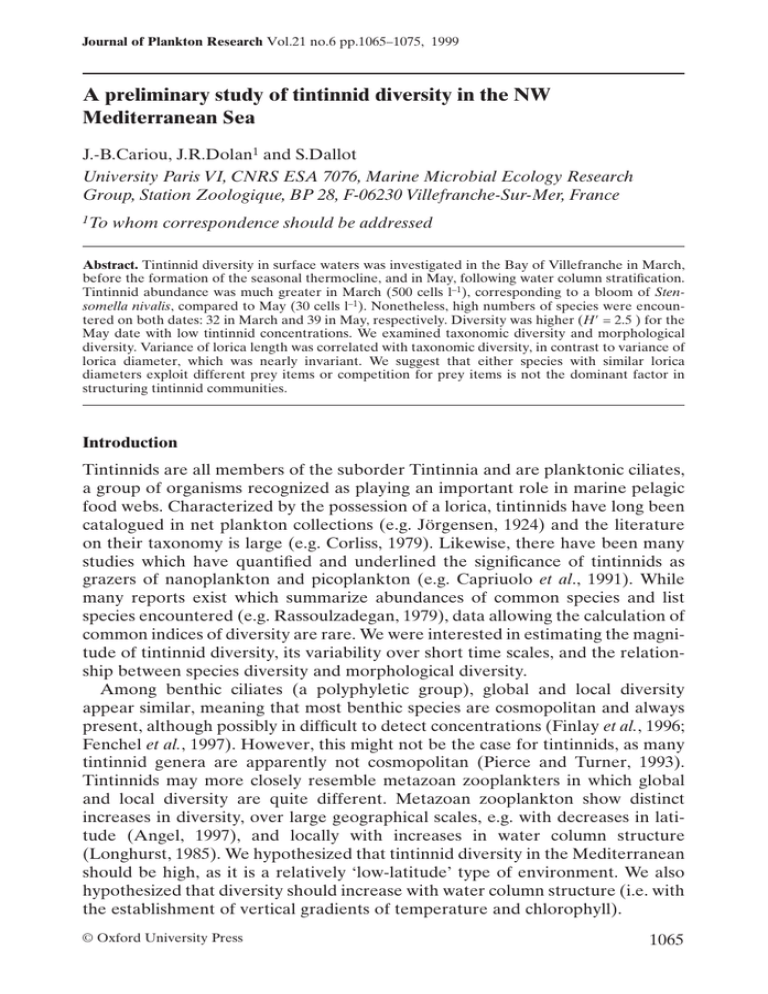
Journal of Plankton Research Vol.21 no.6 pp.1065–1075, 1999 A preliminary study of tintinnid diversity in the NW Mediterranean Sea J.-B.Cariou, J.R.Dolan1 and S.Dallot University Paris VI, CNRS ESA 7076, Marine Microbial Ecology Research Group, Station Zoologique, BP 28, F-06230 Villefranche-Sur-Mer, France 1To whom correspondence should be addressed Abstract. Tintinnid diversity in surface waters was investigated in the Bay of Villefranche in March, before the formation of the seasonal thermocline, and in May, following water column stratification. Tintinnid abundance was much greater in March (500 cells l–1), corresponding to a bloom of Stensomella nivalis, compared to May (30 cells l–1). Nonetheless, high numbers of species were encountered on both dates: 32 in March and 39 in May, respectively. Diversity was higher (H9 = 2.5 ) for the May date with low tintinnid concentrations. We examined taxonomic diversity and morphological diversity. Variance of lorica length was correlated with taxonomic diversity, in contrast to variance of lorica diameter, which was nearly invariant. We suggest that either species with similar lorica diameters exploit different prey items or competition for prey items is not the dominant factor in structuring tintinnid communities. Introduction Tintinnids are all members of the suborder Tintinnia and are planktonic ciliates, a group of organisms recognized as playing an important role in marine pelagic food webs. Characterized by the possession of a lorica, tintinnids have long been catalogued in net plankton collections (e.g. Jörgensen, 1924) and the literature on their taxonomy is large (e.g. Corliss, 1979). Likewise, there have been many studies which have quantified and underlined the significance of tintinnids as grazers of nanoplankton and picoplankton (e.g. Capriuolo et al., 1991). While many reports exist which summarize abundances of common species and list species encountered (e.g. Rassoulzadegan, 1979), data allowing the calculation of common indices of diversity are rare. We were interested in estimating the magnitude of tintinnid diversity, its variability over short time scales, and the relationship between species diversity and morphological diversity. Among benthic ciliates (a polyphyletic group), global and local diversity appear similar, meaning that most benthic species are cosmopolitan and always present, although possibly in difficult to detect concentrations (Finlay et al., 1996; Fenchel et al., 1997). However, this might not be the case for tintinnids, as many tintinnid genera are apparently not cosmopolitan (Pierce and Turner, 1993). Tintinnids may more closely resemble metazoan zooplankters in which global and local diversity are quite different. Metazoan zooplankton show distinct increases in diversity, over large geographical scales, e.g. with decreases in latitude (Angel, 1997), and locally with increases in water column structure (Longhurst, 1985). We hypothesized that tintinnid diversity in the Mediterranean should be high, as it is a relatively ‘low-latitude’ type of environment. We also hypothesized that diversity should increase with water column structure (i.e. with the establishment of vertical gradients of temperature and chlorophyll). © Oxford University Press 1065 J.-B.Carious, J.R.Dolan and S.Dallot We were also interested in examining the relationship between species diversity and the diversity of tintinnid lorica morphologies. However, whether diversity should be reflected in varieties of lorica diameters or lengths is unclear. Lorica diameter is related to the maximum size of food particle that a tintinnid can ingest (Spittler, 1973; Heinbokel, 1978). Overall community averages of lorica diameter change seasonally and are thought to reflect changes in the size spectrum of food particles (Middlebrook et al., 1987; Verity, 1987; Gilron et al., 1991). If diversity is related closely to partitioning of food resources, variance in lorica diameter, indicating a variety of at least maximum sizes for food, should increase with diversity. Lorica length, or overall size, may have both costs and benefits. Lorica length has occasionally been related to susceptibility to copepod predation with large tintinnids hypothesized to be more subject to predation from copepods than smaller species (Ayukai, 1987). However, size can also confer an advantage in that bigger cells are thought to have lower minimum food requirements, in terms of bulk concentrations, relative to smaller ciliates, as larger ciliates can more easily exploit prey distributed in ‘patches’ (Rassoulzadegan, 1993). We were interested in estimating the magnitude of tintinnid diversity, the influence of water column structure and the relationship of species diversity with morphological diversity. We sampled on two spring dates before and then during the formation of the seasonal thermocline in coastal waters of the NW Mediterranean. We also compare the diversity found at a single point in the western Mediterranean with data from previous studies which examined diversity over larger space and time scales in the Mediterranean Sea. Method We examined tintinnid populations in the Bay of Villefranche in samples from a standard station ‘Point B’ (43°419100N, 7°199000E). On 18 March and 6 May 1998, triplicate water samples were obtained from 0, 10, 20, 30, 40 and 50 m using 5 l Niskin bottles. Temperature and salinity were measured using a Seabird CTD. Chlorophyll a samples were measured fluorometrically following acetone extraction. For tintinnids, each replicate 5 l sample was concentrated to 60 ml using a 20 mm Nitex screen. This method yields tintinnid numbers as high as settling whole-water samples (Pierce and Turner, 1994). The entire concentrate, in 10 ml aliquots, was settled in sedimentation chambers and examined with an inverted microscope at 3200. Thus, for each date, material from 75 l was examined. Tintinnids were identified using lorica morphology and the species descriptions found in Balech (1959), Campbell (1942), Jörgensen (1924) and Kofoid and Campbell (1929, 1939). Lorica dimensions of 10–20 individuals for each species were measured with an ocular micrometer. The Shannon and Simpson diversity indices for each 5 l sample were calculated. Here, we report only Shannon values as Simpson index figures showed the same trends. Sampling error, more specifically the undersampling of rare species, was evaluated by using jack-knife estimates for the cumulative species as a function of the volume of water examined. Diversity indices and jack-knife calculations were made using the ‘Biodiversity Professional’ [beta release; McAleece,N., 1066 Tintinnid diversity in NW Mediterranean Sea Lambshead,P.J.D., Patterson,G.L.J. and Gage,J.D., 1997; distributed by the Natural History Museum, London, through the NHM web site (HTTP://www.NHM.AC.UK/ZOOLOGY/BDPRO)]. Data on lorica diameters and lengths from the triplicate samples were pooled to calculate a variance estimate (SD) of the average lorica dimensions. Results The early spring sampling showed a homogeneous water column in terms of temperature (~14°C) and salinity (38 p.p.t.). Chlorophyll concentrations ranged from ~0.2 to 0.6 µg l–1 with a maximum at ~30 m depth. The tintinnid community was dominated by Stensomella nivalis. Total abundance was high, averaging ~500 cells l–1, and roughly paralleled chlorophyll. The community average lorica diameter was nearly constant with depth and variance of lorica diameter was unrelated to diversity. Abundance of tintinnids was inversely related to diversity with the highest values of indices corresponding to 0 and 50 m depth samples which contained few S.nivalis. Despite the near total dominance of the tintinnid community by S.nivalis, reflected in H9 values of near zero at 30 m (Figure 1), a large number of species (32) was encountered (Table I). Data from the late spring sampling showed the establishment of a temperature gradient ranging from 14 to 16°C between 50 and 0 m depth. Chlorophyll concentrations were similar to those of March with, however, higher concentrations at near-surface depths. Tintinnid concentrations were much lower than in March, averaging ~40 cells l–1, and diversity was markedly higher with H9 values between 2.5 and 3. A more even distribution among species was evident (Figure 2). Diversity was unrelated to tintinnid abundance. As in March, community lorica averages did not vary significantly with depth nor was variance relatable to diversity. Fig. 1. Data from the 18 March sampling. Vertical profiles of temperature, salinity, chlorophyll a concentration, tintinnid abundance, diversity and variance (SD) of average community lorica dimensions. 1067 J.-B.Carious, J.R.Dolan and S.Dallot Table I. Tintinnid species found on 18 March. Lengths and diameters refer to lorica dimensions in micrometers Species No. of specimens Length Diameter Acanthostomella conicoides Acanthostomella obtusa Amphorella minor Amphorella quadrilineata Amphorella sp. a Amphorellopsis acuta Codonella aspera Codonella galea Codonellopsis lata Codonellopsis orthoceras Codonellopsis pusilla Codonellopsis schabi Craterella armilla Craterella oxyura Cyttarocylis eucecryphalus Dictyocysta lepida Dictyocysta speciosa Dadayiella ganymedes Eutintinnus fraknoii Eutintinnus inflatus Eutintinnus tubulosus Proplectella claparedei Protorhabdonella curta Salpingella attenuata Salpingella laminata Steenstrupiella steenstrupii Stensomella nivalis Stensomella ventricosa Tintinnopsis beroidea Tintinnopsis levigata Tintinnopsis radix 13 16 76 4 2 1 25 8 1 2 63 86 8 3 1 3 2 36 2 1 11 24 3 1 272 7 24 165 467 6 22 1 35.4 28 96.6 155 34 66 94.3 107 34.5 250 38 108.5 31 31.2 127 71.4 72.5 94 340 94 141.5 76.5 42 290.7 65.5 130 47.8 93.3 82.4 73.2 357 20 16 40.4 56 11 31 54.5 68.8 21 66 16.5 41.4 31 19.5 117 43.5 48 25.8 54.5 25 31.8 39.8 31 35 11.5 41 20 45 34.8 35.9 46 The community average of lorica diameter was very similar to the March date, although a larger number of species (39) was found (Table II). The importance of S.nivalis in the March samples was clear in comparing Kdominance curves of the March and May communities (Figure 3). The March community of tintinnids was ~95% composed of individuals of S.nivalis. In the May samples, the most common species, Acanthostomella conicoides, represented ~20% of total individuals. Plotting the jack-knife estimations of numbers of species as a function of volumes of water examined showed a good agreement between estimated numbers of species and actual values (Figure 4). For both sampling dates, undersampling of rare species may have represented an underestimation of total numbers of species by 5–10. Variance of lorica length was much greater than lorica diameter in both the March and May communities (Figures 1 and 2). Variances in lorica length were positively correlated with taxonomic diversity, in contrast to variance in lorica diameter (Figure 5). 1068 Tintinnid diversity in NW Mediterranean Sea Fig. 2. Data from the 6 May sampling. Vertical profiles of temperature, salinity, chlorophyll a concentration, tintinnid abundance, diversity and variance (SD) of average community lorica dimensions. Fig. 3. K-dominance curves of the March and May tintinnid communities. The March community was overwhelmingly dominated by S.nivalis. In May, the most abundant species was A.conicoides, accounting for ~20% of the total number of individuals. Discussion Our data could be critiqued on the grounds that basing tintinnid species identification on lorica morphology can be hazardous. Although less than ideal, lorica morphology is generally used as tintinnid infraciliature, the basis of alpha-level ciliate taxonomy (Corliss, 1979), has been described for very few species (Choi et al., 1992; Petz and Foissner, 1993). While some tintinnid species are apparently capable of expressing different lorica morphologies (Gold and Morales, 1976; Davis, 1981; Laval-Peuto, 1983; Wasik and Mikolajczyk, 1994), studies of field populations have rarely shown co-existence of different lorica morphotypes of the same species. 1069 J.-B.Carious, J.R.Dolan and S.Dallot Table II. Tintinnid species found on 6 May. Lengths and diameters refer to lorica dimensions in micrometers Species No. of specimens Length Diameter Acanthostomella conicoides Acanthostomella minutissima Amphorella laackmanni Amphorella minor Amphorella quadrilineata Canthariella prymidata Climacocylis scalaroides Codonella aspera Codonella galea Codonellopsis pusilla Codonellopsis schabi Craterella armilla Craterella oxyura Craterella torulata Cyttarocylis eucecryphalus Dadayiella curta Dadayiella cuspis Dadayiella ganymedes Dictyocysta mitra Dictyocysta speciosa Eutintinnus apertus Eutintinnus fraknoii Eutintinnus medius Eutintinnus tenuis Eutintinnus tubulosus Favella serrata Proplectella claparedei Protorhabdonella curta Salpingella attenuata Salpingella gracilis Salpingella laminata Steenstrupiella steenstrupii Stensomella nivalis Stensomella ventricosa Tintinnopsis beroidea Tintinnopsis campanula Tintinnopsis levigata Tintinnopsis lobiancoi Tintinnopsis radix 462 3 2 260 1 1 6 6 5 6 6 3 10 1 1 1 1 151 2 6 18 20 2 1 32 1 9 195 6 6 79 285 432 20 1 11 2 1 127 35.4 34 66 93.4 155 53 194.5 94.3 107 42 108.5 31 31.2 31.5 127 169 80 93.7 73 72.5 70 380 255 270 158 316 76.5 44.7 358 375.5 127.3 132 47.8 93.3 82.4 178.5 73.2 400 360 20 31 20 37.3 55 28 35 54.5 68.8 17.5 41.4 31 19.5 20.5 115 26 26 27.9 44 48 38 59 50 46 31.8 100 39.8 25.9 36.3 38 11.5 37.1 20 44.9 34.8 117 35.9 137.7 47.8 We found a large number of tintinnid species on both sampling dates. We believe that this results from the considerable effort invested in examining material screened from large volumes of water using a fine-mesh (20 µm) screen. Our sampling error can be gauged by comparing jack-knife estimations of species expected versus actual numbers (Magurran, 1988) and indicates that few ‘rare’ species were missed in the volumes of water sampled (Figure 6). We found differences between the two sampling dates, corresponding to differences in water column conditions. The relatively ‘unstructured’ water column on 18 March harbored a more abundant but less diverse tintinnid community compared to the 6 May sampling (Figures 1 and 2). However, the differences 1070 Tintinnid diversity in NW Mediterranean Sea Fig. 4. Jack-knife estimations of species expected in a given volume of water (number of samples) compared to actual data. Note that, for both dates, the jack-knife estimates indicate that few rare species were undersampled. Fig. 5. Cumulative numbers of species versus individuals examined, for the March and May samplings. between the two dates were largely the result of the presence of an abundant population of one species on 18 March: S.nivalis. It is noteworthy that the bloom of S.nivalis did not appear to exclude other species, i.e. there were still large numbers of species present, and S.nivalis bloomed against a background of a sparse yet diverse tintinnid community. Comparison of the two dates, excluding all data on S.nivalis, yielded similar values of total community abundance as well as diversity indices (data not shown). While recognizing the inherent limits of only two sampling dates, it appears that both structured and unstructured water columns can harbor diverse tintinnid communities. On both dates, diversity appeared unrelated to trophic specialization, at least as indicated by varieties in lorica diameter. Overall, these observations lead to the suggestion that either species with similar lorica diameters exploit different prey items or competition for prey items is not the dominant factor in structuring tintinnid communities. Taxonomic diversity was related to variance in lorica length (Figure 5) and one possible force promoting such morphological diversity 1071 J.-B.Carious, J.R.Dolan and S.Dallot Fig. 6. Plots of Shannon index values of taxonomic diversity against measures of morphological diversity, population variances (SD) of tintinnid community lorica diameter and lorica length. Average values of the discrete depth replicates for both the March and May samplings (n = 10). may be predation pressure. While data are sparse (reviewed in Stoecker and Capuzzo, 1990), there is some evidence suggesting that predation on tintinnids by copepods is influenced by the size of the tintinnid. However, the relationship may not be simple. Most studies have dealt with copepod species of the genus Acartia in which maximum reported predation rates do not appear to vary in a linear manner as a function of tintinnid lorica volume; species with very large loricas may be less subject to copepod predation (Figure 7). It is worthwhile recalling that size also involves trade-offs in terms of cellular energetics, with larger size associated with a capability to exploit lower minimum food concentrations (Rassoulzadegan, 1993), but associated with lower maximum growth rate (Pérez et al., 1997). These relationships are obscured further in tintinnids as lorica volume is apparently a poor predictor of cell plasma volume (Gilron and Lynn, 1989). We found ~40 species in a single location on a single date in the western Mediterranean by examining ~3000 individuals. It may be of interest to determine whether using this effort over larger time and space scales would reveal more species. One method of approaching this question is through consideration of data from studies on larger temporal and spatial scales, plotting numbers of individuals versus numbers of species (Gray, 1997). Sample data from a study of the Catalan Sea and a transect across the Mediterranean are plotted in Figure 8 for comparison with our single date and place data from the 6 May sampling. The Catalan Sea samples were gathered from six stations along a 100-nautical-mile transect over a period of 5 days in June (see Dolan and Marrasé, 1995). The Mediterranean transect data were based on samples from 18 stations gathered over a 4 week period in May and June along a cruise track of ~1600 nautical miles (see Dolan et al., 1999). Both studies employed sedimentation of whole-water 1072 Tintinnid diversity in NW Mediterranean Sea Fig. 7. Results from various laboratory studies of copepods of the genus Acartia offered tintinnid ciliates as prey; maximum reported clearance rates as a function of tintinnid lorica volume [data from Stoecker and Capuzzo (1991), Table 4]. Note that copepod clearance rates do not show a simple linear relationship with tintinnid lorica volume, both small and large forms appear to be cleared less efficiently than intermediate-sized tintinnids. The common Mediterranean species of Acartia is A.clausi. Fig. 8. Area–species curves for the May sampling at Point B compared to curves from a study of the Catalan Sea (data from Dolan and Marassé, 1995), and transects across the western basin of the Mediterranean (West Basin), and across the western, central and eastern basins (trans Med) of the Mediterranean (data from Dolan et al., 1999). samples, comparable to samples concentrated with a fine-mesh (20 µm) net (Pierce and Turner, 1994). Interestingly, the data suggest that employing low to intermediate levels of effort (examining <500 individuals) can reveal similar numbers of species in samples gathered from locations separated by tens of kilometers and a few days, compared to a single site on a single date. In contrast, when the spatial scale and temporal scale of sampling are increased to hundreds of kilometers and weeks, even low levels of effort appear to yield more species and, employing high levels 1073 J.-B.Carious, J.R.Dolan and S.Dallot of effort (examination of 3103 individuals), the number of species encountered increases markedly with the temporal and spatial scales of sampling. Thus, in tintinnids, it appears that local and global diversity are different, resembling more the patterns found in planktonic metazoans (e.g. Angel, 1997) rather than those in benthic ciliates (Finlay et al., 1996). Acknowledgements The research reported here is based in part on a ‘Rapport du Stage’ submitted by J.B.C. to the Université Pierre et Marie Curie (Paris VI) in partial fulfillment of the requirements for a D.E.A. degree in Biological Oceanography. Financial support was provided by the Commission of the European Communities Grant MAS3-CT95-0016, MEDEA, the Centre National de Recherche Scientifique (France) and the Université Paris VI. This paper was greatly improved through the efforts of two anonymous reviewers. Station B hydrological data were provided by the SOMLIT Program (CNRS-INSU) and are available at WWW.OBS-VLFR.FR/RADE References Angel,M.V. (1997) Pelagic biodiversity. In Ormond,R.F.G., Gage,J.D. and Angel,M.V. (eds), Marine Biodiversity: Patterns and Processes. Cambridge University Press, Cambridge, pp. 35–68. Ayukai,T. (1987) Predation by Acartia clausi (Copepoda: Calanoida) on two species of tintinnids. Mar. Microb. Food Webs, 2, 45–52. Balech,E. (1959) Tintinoinea del Mediterráneo. Instituto EspaMediterráneoo species of tintCampbell,A.S. (1942) The Oceanic Tintinnoina of the Plankton Gathered During the Last Cruise of the Carnegie. Carnegie Institution of Washington Publication 537. Washington, DC. Capriuolo,G.M., Sherr,E.B. and Sherr,B.F. (1991) Trophic behaviour and related community feeding activities of heterotrophic marine protists. In Reid,P.C., Turley,C.M. and Burkill,P.H. (eds), Protozoa and their Role in Marine Processes. Springer-Verlag, Berlin, pp. 219–279. Choi,J.K., Coats,D.W., Brownlee,D.C. and Small,E.B. (1992) Morphology and infraciliature of three species of Eutintinnus (Ciliophora: Tintinnia) with guidelines for interpreting protargol-stained tintinnine ciliates. J. Protozool., 39, 80–92. Corliss,J.O. (1979) The Ciliated Protozoa, Characterization, Classification and Guide to the Literature, 2nd edn. Pergamon Press, London. Davis,C.C. (1981) Variations of lorica shape in the genus Pytochocylis (Protozoa: Tintinnia) in relation to species identification. J. Plankton Res., 3, 433–443. Dolan,J.R. and Marrasé,C. (1995) Planktonic ciliate distribution relative to a deep chlorophyll maximum: Catalan Sea, N. W. Mediterranean, June 1993. Deep-Sea Res. I, 42, 1965–1987. Dolan,J.R., Vidussi,F. and Claustre,H. (1999) Planktonic ciliates in the Mediterranean Sea: longitudinal trends. Deep-Sea Res. I, in press. Fenchel, T., Esteban,G.F. and Finlay,B.J. (1997) Local versus global diversity of microorganisms: cryptic diversity of ciliated protozoa. Oikos, 80, 220–225. Finlay,B.J., Esteban,G.F. and Fenchel,T. (1996) Global diversity and body size. Nature, 383, 132–133. Gilron,G.L. and Lynn,D.H. (1989) Assuming a 50% cell occupancy of the lorica overestimates tintinnine ciliate biomass. Mar. Biol., 103, 413–416. Gilron,G.L., Lynn,D.H. and Roff,J.C. (1991) The annual cycle of biomass and production of tintinne ciliates in a tropical neritic region near Kingston, Jamaica. Mar. Microb. Food Webs, 5, 95–113. Gold,K. and Morales,E. (1976) Studies on the sizes, shapes, and the development of the lorica of agglutinated Tintinnida. Biol. Bull., 150, 377–392. Gray,J.S. (1997) Gradients in marine biodiversity. In Ormond,R.F.G., Gage,J.D. and Angel,M.V. (eds), Marine Biodiversity: Patterns and Processes. Cambridge University Press, Cambridge, pp. 18–34. Heinbokel,J.F. (1978) Studies on the functional role of tintinnids in the Southern California Bight I. Grazing and growth rates in laboratory cultures. Mar. Biol., 52, 23–32. 1074 Tintinnid diversity in NW Mediterranean Sea Jörgensen,E. (1924) Mediterranean Tintinnidae. Report of the Danish Oceanographical Expeditions 1908–1910 to the Mediterranean and Adjacent Seas, Volume II, Biology, No. 8, J.3 (Thor expedition). Andr. Fred. Høst and Son, Copenhagen. Kofoid,C.A. and Campbell,A.S. (1929) A conspectus of the marine and fresh-water ciliata belonging to the suborder Tintinnoinea, with descriptions of new species principally from the Agassiz expedition to the eastern tropical Pacific 1904–1905. Univ. Calif. Pub. Zool., 34, 1–403. Kofoid,C.A. and Campbell,A.S. (1939) The Tintinnoinea of the eastern Tropical Pacific. Bull. Mus. Comp. Zool. Harvard Coll., 84, 1–473. Laval-Peuto,M. (1983) Sexual reproduction in Favella ehrenbergii (Ciliophora, Tintinnia) taxonomical implications. Protistologica, 19, 503–512. Longhurst,A.R. (1985) Relationship between diversity and the vertical structure of the upper ocean. Deep-Sea Res., 32, 1535–1570. Magurran,A.E. (1988) Ecological Diversity and its Measurement. Croom Helm, London. Middlebrook,K., Emerson,C.W., Roff,J.C. and Lynn,D.H. (1987) Distribution and abundance of tintinnids in the quoddy region of the bay of Fundy. Can. J. Zool., 65, 594–601. Pérez,M.T., Dolan,J.R. and Fukai,E. (1997) Planktonic oligotrich ciliates in the NW Mediterranean: growth rates and consumption by copepods. Mar. Ecol. Prog. Ser., 155, 89–101. Petz,W. and Foissner,W. (1993) Morphogenesis in some freshwater tintinnids (Ciliophora, Oligotrichida). Eur. J. Protist., 29, 106–120. Pierce,R.W. and Turner,J.T. (1993) Global biogeography of marine tintinnids. Mar. Ecol. Prog. Ser., 94, 11–26. Pierce,R.W. and Turner,J.T. (1994) Plankton studies in buzzards Bay, Massachusetts, USA. IV. Tintinnids, 1987 to 1988. Mar. Ecol. Prog. Ser., 112, 235–240. Rassoulzadegan,F. (1979) Evolution annuelle des cilés pélagiques en Méditerranée nord-occidentale. II. Cilés oligotriches. Tintinnides (Tintinnia). Invest. Pesq., 43, 417–448. Rassoulzadegan,F. (1993) Protozoan patterns in the Azam-Ammerman’s bacteria-phytoplankton mutualism. In Guerrero,R. and Pedros-Alio,C. (eds), Trends in Microbial Ecology. Spanish Society for Microbiology, Barcelona, pp. 435–439. Spittler,P. (1973) Feeding experiments with tintinnids. Oikos, 15, 128–132. Stoecker,D.K. and Capuzzo,J.M. (1990) Predation on protozoa: its importance to zooplankton. J. Plankton Res., 12, 891–908. Verity,P.G. (1987) Abundance, community composition, size distribution and production rates of tintinnids in Narragansett Bay, Rhode Island. Estuarine Coastal Shelf Sci., 24, 671–690. Wasik,A. and Mikolajczyk,E. (1994) Annual cycle of tintinnids in Admiralty Bay with an emphasis on seasonal variabilty in Cymatocylis affinis/convallaria lorica morphology. J. Plankton Res., 16, 1–8. Received on July 7, 1998; accepted on February 4, 1999 1075
